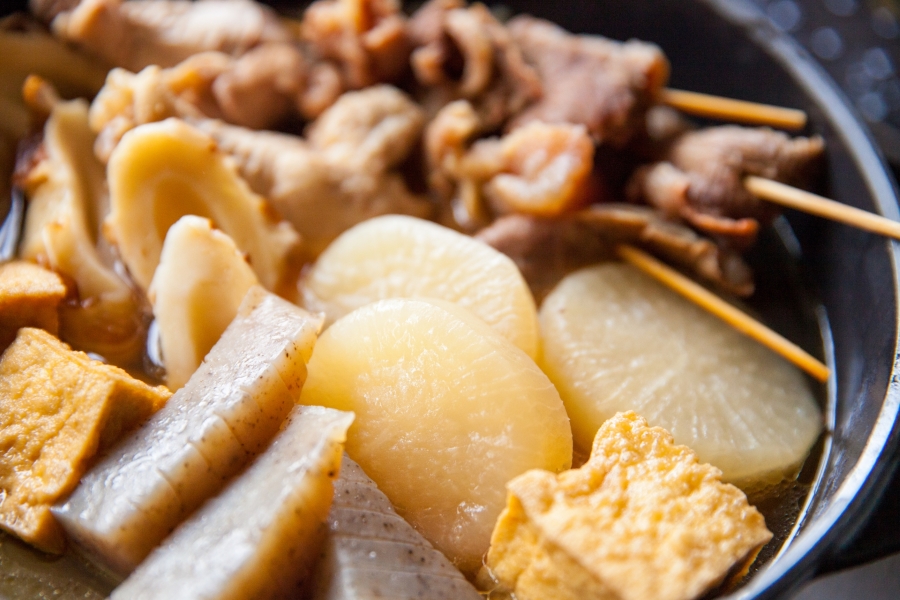Basically, Oden is a Japanese soup made by filling a simmering pot with a dashi soup stock and various ingredients such as daikon (Japanese radish), boiled egg, multiple types of fish cakes, and konnyaku (yam cake). The oden ingredients are simmered in the pot for hours, or even days, and when you bite into the ingredients your mouth will be filled with the juicy flavorful soup. Yum! Also, once you have enjoyed your soup you can then add rice or noodles at the end for another delicious meal.
Contents:
- What is Oden?
- Oden by Regions of Japan
- 15 Most Popular Oden Ingredients
- Assorted Fish Cake Sets and Oden Soups
- How to cook Oden?
What is Oden?
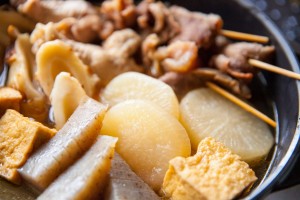 If you heard of oden before then you must be a real Japanese food connoisseur. Oden has yet to really make its way out of Japan and into mainstream western cuisine, but it is a hearty and delicious hot pot meal very popular in Japan, especially during cold winter days.
If you heard of oden before then you must be a real Japanese food connoisseur. Oden has yet to really make its way out of Japan and into mainstream western cuisine, but it is a hearty and delicious hot pot meal very popular in Japan, especially during cold winter days.
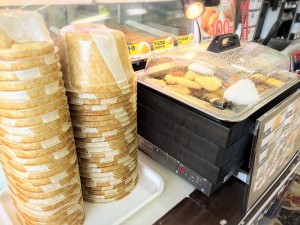
Oden at convenience store in Japan
Oden by Regions of Japan
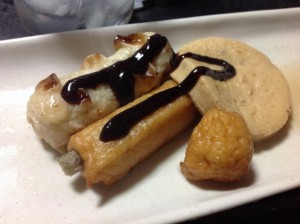
15 Most Popular Oden Ingredients
Oden is one of those easy to cook meals. Just put the ingredients and the dashi (broth) in a pot and simmer it for couple of hours or, if you plan ahead, overnight. If you have a slow cooker, put everything in that and let it cook. After a couple of hours you will have a hearty meal. Here are some the popular ingredients for oden commonly available here in the U.S. Some of the ingredients listed below, such as potatoes, are better to put in the pot at a later stage so they won’t be dissolving in the soup. Vegetarian options are marked with an asterisk [*].
1. Daikon (Japanese radish) *
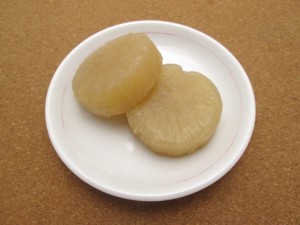 Daikon is great for any hot pot dish, especially oden. As it simmers it soaks up the all the yummy flavors in your soup. Professional chefs and some home cooks will precook the daikon to reduce its bitterness. The way to precook daikon is skin it, cut in chunks and boil it with water along with 1 tablespoon of rice.
Daikon is great for any hot pot dish, especially oden. As it simmers it soaks up the all the yummy flavors in your soup. Professional chefs and some home cooks will precook the daikon to reduce its bitterness. The way to precook daikon is skin it, cut in chunks and boil it with water along with 1 tablespoon of rice.
2. Tamago (boiled egg)
Tamago, hard-boiled egg, is another classic protein ingredient in oden. It will taste better the longer you simmer it in the pot.
3. Konnyaku *
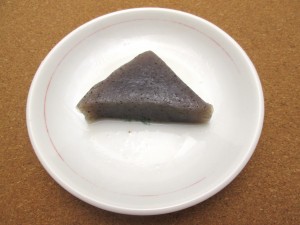 Konnyaku is made from the vegetable called konjac, which is similar to yam. Konnyaku is very low in calories and has lots of fiber. It is regarded as one of the most healthy diet foods in Japan. Konnyaku is a regular in Japanese hot pot dishes, but it is flavorless so it is better to make shallow cuts on the surface of konnyaku so it can easily soak up the flavor of the soup.
Konnyaku is made from the vegetable called konjac, which is similar to yam. Konnyaku is very low in calories and has lots of fiber. It is regarded as one of the most healthy diet foods in Japan. Konnyaku is a regular in Japanese hot pot dishes, but it is flavorless so it is better to make shallow cuts on the surface of konnyaku so it can easily soak up the flavor of the soup.
4. Chikuwa
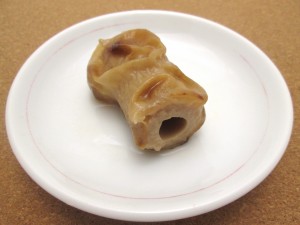 Chikuwa literally means ‘bamboo ring’ in Japanese. Chikuwa is a fish cake shaped like a tube and is formed by wrapping ground fish around a piece of bamboo or a stick and then cooking it. Chikuwa has more texture than other fish cakes and Japanese like to eat chikuwa stuffed with cheese, but don’t use this in your oden.
Chikuwa literally means ‘bamboo ring’ in Japanese. Chikuwa is a fish cake shaped like a tube and is formed by wrapping ground fish around a piece of bamboo or a stick and then cooking it. Chikuwa has more texture than other fish cakes and Japanese like to eat chikuwa stuffed with cheese, but don’t use this in your oden.
5. Mochi iri kinchaku (rice cake in fried tofu) *
Mochi iri kinchaku simply means mochi (rice cake) in a small bag. The kinchaku is aburaage (fried tofu) cut in half and then you put the mochi in the open pocket. Mochi will melt in the soup if cooked for a long time and that is why it is stuffed put in the kinchaku. Make sure you don’t cook mochi iri kinchaku too long.
6. Hanpen
Hanpen is another type of fish cake which is made with white fish and yam. The texture is much fluffier than other fish cakes and is great in all soup dishes as well as stews.
7. Atsuage *
Atsuage is also fried tofu, and the difference between atsuage and aburaage is the outside of the tofu is fried while the inside is keeps its regular tofu texture.
8. Jagaimo (potatoes) *
Note that you may want to add the potatoes at a later stage so it will not dissolve in the soup.
9. Shirataki *
Shritaki is basically a noodle made from konnyaku, number three in this list. When putting in the pot, tie the noodles in a bundle so they are easier to eat. Shirataki is a must have ingredient in any kind of hot pot dish in Japan and it is also a great alternative for those who want gluten free noodles!
10. Ganmodoki *
Ganmodki is fried tofu patty mixed with vegetables such as carrot, gobo (burdock root), shiitake, and yam. It is a vegan meat that was created in the 8th century for Buddhist monks who could not eat meat.
11. Satsuma-age
Satuma-age, another popular ingredient in oden, is a fried fish cake originally from Satsuma, an old name for a district in Kagoshima. Age (pronounced a-gay) means fried and that’s how it got its name. Satuma-age is also delicious by lightly pan frying it and eating it with just a touch of soy sauce.
12. Tsumire
Tsumire is a technique of cooking that uses a spoon to scoop ground meat or fish into a ball and drop it into the soup to cook. Later, it became the name for fish balls made of mackerel or baby sardines.
13. Chikuwabu *
Chikuwabu is a vegan fish cake made with wheat shaped exactly like chikuwa, the tube shaped fish cake. In fact, like ganmodoki, chikuwabu was meant as a vegetarian substitute for Buddhist monks.
14. Sausage
Sausage is a new comer to the items used in oden and many younger moms like to put this in their oden pot to add an additional flavor to the dashi soup. The tip is not to overcook the sausage but leave in the soup just long enough to cook.
15. Gobo maki
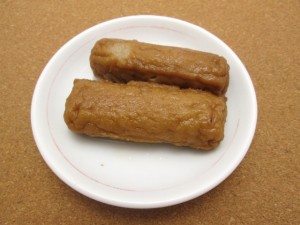 Gobo maki is burdock root wrapped in thinly sliced meat such as beef or pork. Gobo maki is popular in the oden but it is also eaten without the soup at as an appetizer for the New Year’s meal.
Gobo maki is burdock root wrapped in thinly sliced meat such as beef or pork. Gobo maki is popular in the oden but it is also eaten without the soup at as an appetizer for the New Year’s meal.
Assorted Fish Cake Sets and Oden Soups
Fish cakes are a must have ingredient for Japanese or Asian hot pot dishes. The history of fish cakes in Japan goes as far back as the 8th century. The following assorted oden fish cake sets are available at most Japanese supermarkets. All fish cakes are precooked, either fried or steamed, and all you have to do is simmer them in the soup with all your other ingredients.
Kibun Assorted Fish Cake
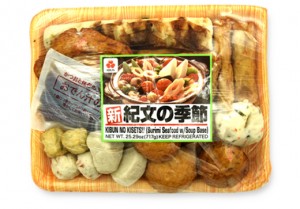 When you think of Kibun, many Japanese will immediately think of Kibun’s Assorted Fish Cakes for oden. Kibun is the major food manufacturing company in Japan known specifically for their fish cake products.
When you think of Kibun, many Japanese will immediately think of Kibun’s Assorted Fish Cakes for oden. Kibun is the major food manufacturing company in Japan known specifically for their fish cake products.
Product Info & Photo Credit: http://www.kibunusa.com/
Shirakiku’s Assorted Fish Cake
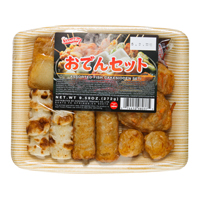 These are also widely available in the U.S. Shirakiku has been in the U.S. market since 1947. If you want to change it up a little, you can replace the dashi soup that comes with the package to a tomato soup or any other kind of soup to create your own hot pot dish!
These are also widely available in the U.S. Shirakiku has been in the U.S. market since 1947. If you want to change it up a little, you can replace the dashi soup that comes with the package to a tomato soup or any other kind of soup to create your own hot pot dish!
House Instant Oden Soup Stock
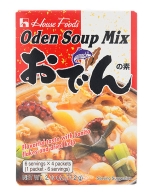 House Instant Oden Soup Stock is great for oden lovers and also for anyone who wants to make oden without the assorted fish cakes. The soup stock is flavored with bonito fish and kombu kelp.
House Instant Oden Soup Stock is great for oden lovers and also for anyone who wants to make oden without the assorted fish cakes. The soup stock is flavored with bonito fish and kombu kelp.
S&B Oden No Moto (soup mix)
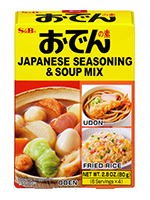 S&B Oden No Moto is a powered soup mix. Just mix it in the water to cook oden. You can also use this soup mix for making udon soup or any other hot pot dishes!
S&B Oden No Moto is a powered soup mix. Just mix it in the water to cook oden. You can also use this soup mix for making udon soup or any other hot pot dishes!
Product Info & Photo Credit: http://www.sbfoods-worldwide.com/
How to cook Oden?
Oden Recipe
Just cut ingredients and simmer together!!
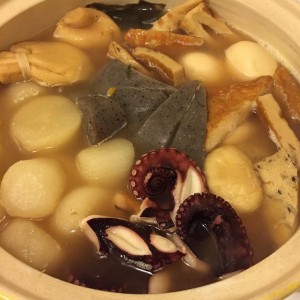
Ingredients (Serves 6-8)
- 4 potatoes (small)
- 4 boiled eggs
- 1/2 daikon (Japanese radish)
- 8 pieces tied kombu
- 1 konnyaku
- 8 ganmodoki (small)
- 1 medium firm tofu
- 2 chikuwa
- 4 tsumire
- 4 satsuma age
Additional tasty ingredients
- 2 chikuwabu
- 2 hampen
- 3.5 oz. beef tendon (or stew beef) *Cut beef into bite-sized pieces and boil. Change water (appropriate amount), add sake (appropriate amount), and cook until the beef becomes tender.
Flavoring ingredients
- 1 liter bonito stock
- 2 tsp. salt
- 2/5 cup sake (cooking sake)
- 2 Tbsp. light soy sauce
- 1 Tbsp. soft brown sugar
Cooking Directions
- Put bonito stock into a clay pot, and soak the tied kombu for several minutes.
- Peel potatoes. Cut daikon into disks and boil.
- Cut konnyaku into triangles. Put konnyaku, ganmodoki, satuma age, and fried bean curd on a bamboo basket, and pour hot water to rinse these off.
- Put the clay pot on the fire, and put beef tendon, daikon, potatoes and konnyaku on the skewers in this order, and cook the ingredients.
- When the ingredients are roughly cooked, add salt, sake, soy sauce and soft brown sugar, then add the tofu, ganmodoki and boiled eggs.
- When the pot starts to boil, reduce heat and cook for about an hour while removing the scum.
- Put chikuwa, tsumire, satsuma age, chikuwabu, hampen, pourches with rice cake and mizuna rolled in fried bean curd, and bring the pot to a boil again. Reduce the heat and simmer until the ingredients absorb the flavorful stock. Eat while hot.
Hint:
- Don’t cook processed fish-meat ingredients too long. Cook over low heat to keep the stock from clouding.
- Oden is called “Kanto Daki” in Kansai area.
Recipe by: Gochiso Magazine, Nijiya Market
